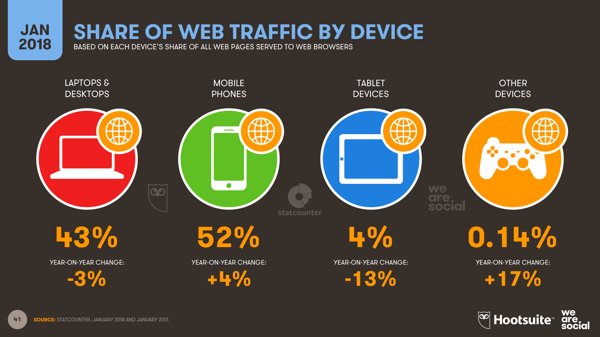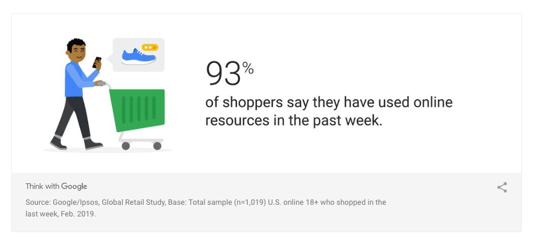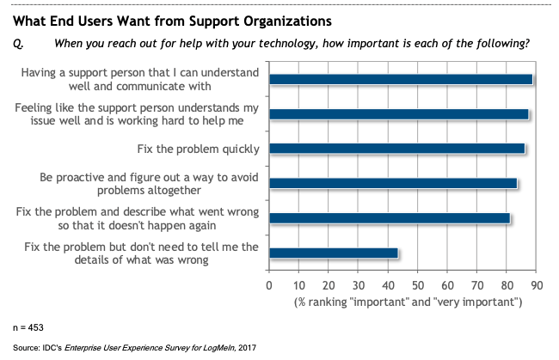
Image from Oregon Coast - The Digital Outdoorsman
1. Growth in mobile web browsing climbing

Mobile web browsing has been steadily growing since 2009, finally surpassing desktop in late 2015. As the latest studies reveal summarized by Junto, the past year has further emphasized the importance of mobile devices in search.
These stats will help you understand why you need to have a mobile-focused web presence. Some of the highlights listed are:
- 66% of eCommerce time takes place on smartphones.
- By 2019, 63.4% of all mobile phone users will access the internet from their smartphone.
- 69% of all digital media time is spent on a mobile device.
- A third of all smartphone searches were made right before a store visit.
- 43% of consumers will do online research even while they’re in the store.
- According to the 2018 SEO statistics, mobile phones were the source of 52.2% of online traffic worldwide.
- 51% of searchers are more likely to purchase from a website that’s been optimized for mobile.
In the end, what should you take away? Search engine optimization is essential to your business’ success and you need to have a clear digital marketing strategy to work from. If your website isn’t mobile-friendly, you need to address making it so NOW. Here are some ideas for improving your mobile checkout.
2. Shopping for outdoor products is increasing. Are you ready?

Some new information from Google Think. People historically have preferred to buy certain things online and other things at brick-and-mortar locations. But the truth is, today’s shoppers like to browse and research online, even in cases when they intend to buy in a store.
Consider this: The percentage of shoppers who have bought sporting goods online grew to over 75% in the first three quarters of last year, significant growth from just six months prior.
Why do people shop online?
The reason why is pretty simple. Many say the online shopping experience is better than in-store when it comes to specific aspects of shopping:
- Better navigation: 66% of shoppers say they prefer online shopping to find items they’re looking for, compared to 27% who say they prefer offline.
- More suggestions and tips: 59% say they prefer to go online to get helpful recommendations or suggestions on what to buy, compared to 28% for offline.
- Better pricing: 59% say they prefer to shop online to get the best deal possible, which is also the number one thing people say they enjoy about shopping.
In other words, people feel that online shopping makes it easier for them to find the right item at the right price. If you want to see an example of how you can build an eCommerce growth machine to capture online sales of outdoor gear check out the case study below.
3. What End Users Expect From Support

In a report by IDC for LogMeIn, they found, "The degree to which support is effective is now a competitive differentiator and should be approached in a more proactive and predictive manner. While most service providers are cognizant of the important role that service and support play in developing and maintaining a partnership with customers, IDC's research has uncovered key areas where existing tools are inadequate and unable to deliver the capabilities required to meet demand."
Four areas they identified that can better enable customer service are:
- Social: For Millennials, social is a preferred method for resolution. The ability to use chat or support forums to resolve issues and the ability to connect with help via multiple modes are becoming table stakes for support organizations.
- Mobile: This refers to the ability to provide support from a smart device and/or provide support to a smart device or laptop simply and easily anytime anywhere.
- Cloud: This provides the user with support or information about any issue anytime from anywhere in a secure and safe manner.
- Big Data/analytics: This involves utilizing data to help troubleshoot and resolve issues quickly, mine data to look for "like" issues to help populate FAQs, and/or create a database repository of recurring issues.
Are you making the most out of the latest remote support tools to deliver best-in-class support and improve the overall customer experience? Check out this video on how chatbots can improve your customer's experience with your brand.
4. Optimizing for Improved SEO

Although SEO cannot stand alone as your only means of marketing, it is the foundation of any digital marketing campaign. Your website is composed of various forms of content: written, video, image, etc. All of this content must constantly be optimized for Google and other search engines — that's how people find content online.
A foundational keyword strategy will help you create everything from blog content to social posts that help promote them. The pages that we determine will drive the most traffic give you ideas on what topics and pages you should be focusing on.
It is really important to have a solid pillar strategy as the foundation to work off of. By having a more focused strategy you are bound to drive better results, rather than spinning your wheels not knowing exactly which pages to focus on and when. Pick the most important pages and stick with them.
In a resource posted by BigCommerce Bill Widmer stated:
"Search engine optimization is a low-hanging fruit for ecommerce websites. Despite the fact that SEO has the highest ROI of any ecommerce marketing campaign, most online shops are put together with little to no consideration of search engines. SEO....requires effort up front — once you rank, you practically make sales on autopilot with no recurring expense."
If you want to improve your eCommerce sales and increase revenue, you need to increase your visibility with search engines. To achieve this, you need to start using the type of SEO strategy and best practices presented above. Here's our guide to SEO and eCommerce.

